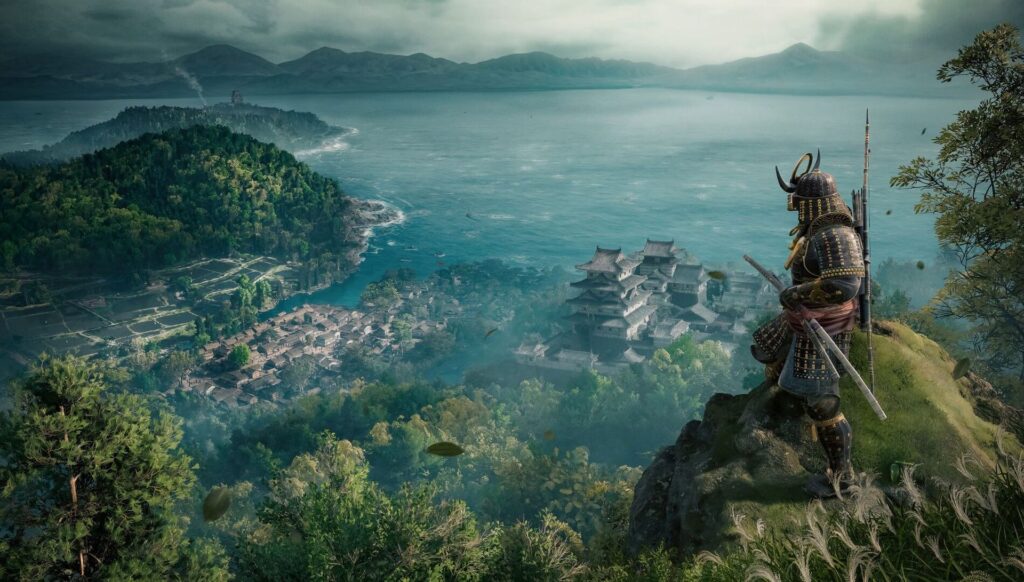Assassin’s Creed Shadows stands out for its excellent depiction of feudal Japan, strong characterisation in its dual protagonists Yasuke and Naoe, and an overall engaging story. However, it is no secret that the incredibly lengthy title—taking anywhere between 30 and 100 hours depending on how much you want to do—has left a few plot threads dangling even as it wrapped up its main story. Some of these plot threads, like the machinations of the Templars and even the fate of Naoe’s mother, have now been expanded on thanks to the first major DLC for the game: Claws of Awaji.
The premise of Claws of Awaji promises to be interesting right off the bat. Our protagonists have learned that Naoe’s mother, Tsuyu, is still alive and is being kept prisoner on the eponymous island of Awaji. Both Naoe and Yasuke decide that it’s up to them to bust her out, with Tsuyu seemingly having a pivotal role in the ultimate fate of Japan in the shadow war against the Templars. The main antagonists this time around are the Sanzoku Ippa, complete with their own hierarchy of captains, generals, assassins, and a spymaster, working under the primary villain for much of the DLC’s story, Yukari, who has her own grand designs for Awaji.
“The story generally has a short runtime, especially when compared to the base game.”
Throughout the time you spend on Awaji, the story keeps a relatively breakneck pace, with events seamlessly guiding you from one objective to the next. Sure, there are a few dips in the pacing, but that’s not a bad thing, since it gives you time to catch your breath as you plan out who from the Sanzoku Ippa you want to target next. Keeping in line with the general mission structure from Assassin’s Creed Shadows, Claws of Awaji also gives you a fair bit of freedom when it comes to deciding your next target, as well as the methods you choose in doing so. The story generally has a short runtime, especially when compared to the base game. This also adds to the feeling of Claws of Awaji offering a more focused experience where unnecessary fat has been trimmed off.
The island of Awaji itself also feels like a more refined take on the more expansive landmass we get to explore and play around in the base game. At first glance, the gloomy island looks quite small, especially compared to some of the larger zones from Assassin’s Creed Shadows. Appearances, however, can be deceiving, and despite its relatively smaller area in terms of raw square footage, the island of Awaji has been expertly designed to make sure that exploring it is still fun and rewarding without the excitement passing by too quickly. This largely comes down to the fact that the island has been designed with verticality in mind.
Awaji is an incredibly mountainous island, with plenty of hills, mountains, plateaus, and valleys. This means that getting from point A to point B seldom ends up being a straightforward journey. Rather, the paths will have you spiral along the sides of mountains, navigate paddy fields, and wade through thick forests as you try to get to your next objective. Even just travelling through the new island can also often be a more exciting affair than simply letting your horse follow a path to your quest marker. The paths are often lined with shinobi or even agents of the Sanzoku Ippa who are trying to swiftly and silently get rid of you. Along with regular ambushes, these enemies also often set up booby traps that, while avoidable if you spot them in time, can and will knock you off your horse if you trigger them.

“When it comes to the general atmosphere, Claws of Awaji does a great job of depicting a rather gloomy island that is under constant oppression by its leadership.”
The island is split into four distinct territories, each with its own atmosphere and themes: Sumoto, Eshima Coast, Fukura Bay, and Yura. Since Claws of Awaji is essentially an endgame expansion, these zones aren’t really level-gated, since you are more or less expected to have hit the level cap and be equipped to take on the appropriate threats. This means that, after wrapping up the introductory quests, you’re free to leave the story behind and just explore the island, looting it for all its worth and getting some handy fast travel points under your belt to make the rest of the expansion fly by even faster.
When it comes to the general atmosphere, Claws of Awaji does a great job of depicting a rather gloomy island that is under constant oppression by its leadership. Military bases, like massive castles, feel like they were designed with more spartan uses in mind rather than the more lavish setups we see in the base game. Similarly, the roads also tend to have military checkpoints, with soldiers constantly harassing villagers.
When it comes to brand-new additions to the game, Claws of Awaji has one headlining new feature in the form of a new weapon type for Naoe—the Bo staff. Rather than simply being a weapon like any other in the game, however, the Bo staff has entirely new combat mechanics that players can learn through one of the earlier missions in the expansion. The Bo staff is a versatile weapon, allowing Naoe to switch between attack types by entering three distinct stances: high, neutral, and low.

“The skill tree adds more versatility to the weapon as a whole”
As you might expect, each of the three stances has its own unique uses. High stance, for instance, focuses on dealing as much damage as possible with its forceful thrusts. Neutral, on the other hand, is useful for creating some distance between you and your opponent, since it causes enemies to get knocked back. Low stance focuses more on controlling the fight, since its attacks can trip enemies to the ground, opening them up to a devastating ground attack. Learning how to use the weapon as part of the expansion’s story also leads to an entirely new skill tree to level through.
The skill tree adds more versatility to the weapon as a whole, since it also tends to expand on the weapon’s capabilities thanks to moves like a flurry of quick hits, a grapple that can throw an enemy onto another, and several passive nodes that give the weapon the ability to better take down enemy posture and even their armour. Generally speaking, the Bo staff feels like a great addition to Assassin’s Creed Shadows as a new, versatile weapon that still manages to feel relatively balanced. You might not be replacing your simple katana with a Bo staff, but you’ll likely end up finding a use for it alongside your primary weapon of choice.
Claws of Awaji also tends to experiment a bit with some of its mission design, with a notable one being a few large-scale battles you take part in early in the expansion. These experiments aren’t really expanded on over the course of the story, however, with the rest of it feeling quite similar to the base game in how it is designed and laid out. This also means that, aside from the inclusion of a brand-new weapon, not much has changed for the core gameplay of Assassin’s Creed Shadows.

“The fact that the DLC doesn’t really expect you to spend any time grinding up levels or gear means that its pacing doesn’t suffer from any padding.”
Since its original release earlier this year, Assassin’s Creed Shadows has seen several free updates that have brought with them a host of improvements over time. These same improvements can also be seen on full display in Claws of Awaji, since the expansion runs quite well when it comes to striking a balance between visual fidelity and performance. Running the game on a PC powered by an AMD Ryzen 7 7800X3D CPU, 32 GB of DDR-6000 RAM, and an AMD Radeon RX 7800 XT GPU with 16 GB of VRAM, I was able to max out Assassin’s Creed Shadows and Claws of Awaji on the graphics side of things while running at a resolution of 2560 x 1440. Keeping FSR 3 set to Quality, I was able to get decent frame rates between 70 and 80 throughout my time with the DLC, with zero problems such as stuttering or poor visuals.
Assassin’s Creed Shadows: Claws of Awaji is an interesting take on an expansion. The base game itself is incredibly long, which could in turn make returning to it a difficult proposition for those that may have already spent hundreds of hours with it. However, the fact that the DLC doesn’t really expect you to spend any time grinding up levels or gear means that its pacing doesn’t suffer from any padding. The story also feels incredibly focused, and runs at a brisk pace with plenty of logical points where you can take a break.
This, coupled with the fact that it’s got an ideal runtime of between 10 and 13 hours for its main story, makes Claws of Awaji feel like a refinement over what we saw with the base game. The Bo staff also serves as an excellent new addition to further flesh out Naoe’s toolkit and give her more options if she gets into a fight. Serving as a refinement over a game that was already considered to be a return to form is reason enough for us to recommend Claws of Awaji wholeheartedly to anyone that might have enjoyed their time with Assassin’s Creed Shadows. If you aren’t already a fan of the base game, however, you won’t find anything in Claws of Awaji to change your mind, especially since you also need to go through the base game to access it.
This game was reviewed on PC.




This review highlights some intriguing aspects of Assassin’s Creed Shadows, especially the setting and character development. It’s great to see the series exploring feudal Japan in such depth. Looking forward to seeing how this installment evolves the core ideas!
I completely agree! The attention to detail in feudal Japan really enhances the game’s atmosphere. It’s fascinating how the cultural elements are interwoven with the gameplay mechanics, creating a unique experience that immerses players even further in that historical context.
Absolutely, the environment truly immerses players in the setting. Plus, the way the game weaves historical events into the storyline adds depth to the characters’ motivations and actions, making the experience even more engaging.
Appreciate this post—concise and informative.
Thank you! I’m glad you found it helpful. The game’s attention to historical details really enhances the immersive experience, making players feel truly connected to the feudal Japan setting.
Absolutely! The way the game incorporates traditional Japanese art and architecture adds a rich layer to the experience. It truly immerses players in that era while keeping the core gameplay engaging.